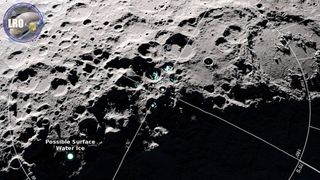Water atoms are jumping around the moon as the lunar surface warms and cools for the duration of the day, new research proposes.
That examination depends on perceptions accumulated by NASA's Lunar Reconnaissance Orbiter, which has been concentrating our planet's nearby sidekick since 2009. An ongoing move up to an instrument installed the orbiter called Lyman-Alpha Mapping Project (LAMP) has enabled researchers to watch out for where the moon's surface hints at the water.

"This is a vital new outcome about lunar water, an interesting issue as our country's space program profits to a concentration for lunar investigation," Kurt Retherford, a co-creator on the new research and the primary agent of the LAMP instrument at Southwest Research Institute in Texas, said in a NASA articulation.
Water on other planetary bodies could be a significant asset for human pilgrims to drink, yet additionally to fill in as fuel for future mechanical investigation, since water can be part to shape rocket fuel, sparing missions from conveying that fuel from Earth.
Yet, it was just in 2009 that researchers had the capacity to affirm that there was water secured up ice on the moon's surface. Presently, they have followed how singular water atoms tie and discharge from the rough regolith as temperatures change through the span of the moon's monthlong sunshine cycle.
As per the specialists' perceptions, water particles stay adhered to the surface all through the lunar morning. As the area heats up around lunar early afternoon, a portion of the particles lift off into the moon's weak air and relocate around the moon's surface until they discover somewhere chilly enough that they can settle down to the surface.
"More work is expected to completely represent the complexities of the lunar surface, yet the present outcomes demonstrate that [this] work is unquestionably worth doing!" Michael Poston, a co-creator on the new research and an examination researcher on the LAMP group at Southwest Research Institute, said in an announcement.
The exploration was portrayed in a paper distributed Feb. 21 in the diary Geophysical Research Letters.
Mining Moon Ice: Prospecting Plans Starting to Take Shape
Photographs: The Search for Water on the Moon
NASA Is Studying How to Mine the Moon for Water
That examination depends on perceptions accumulated by NASA's Lunar Reconnaissance Orbiter, which has been concentrating our planet's nearby sidekick since 2009. An ongoing move up to an instrument installed the orbiter called Lyman-Alpha Mapping Project (LAMP) has enabled researchers to watch out for where the moon's surface hints at the water.

"This is a vital new outcome about lunar water, an interesting issue as our country's space program profits to a concentration for lunar investigation," Kurt Retherford, a co-creator on the new research and the primary agent of the LAMP instrument at Southwest Research Institute in Texas, said in a NASA articulation.
Water on other planetary bodies could be a significant asset for human pilgrims to drink, yet additionally to fill in as fuel for future mechanical investigation, since water can be part to shape rocket fuel, sparing missions from conveying that fuel from Earth.
Yet, it was just in 2009 that researchers had the capacity to affirm that there was water secured up ice on the moon's surface. Presently, they have followed how singular water atoms tie and discharge from the rough regolith as temperatures change through the span of the moon's monthlong sunshine cycle.
As per the specialists' perceptions, water particles stay adhered to the surface all through the lunar morning. As the area heats up around lunar early afternoon, a portion of the particles lift off into the moon's weak air and relocate around the moon's surface until they discover somewhere chilly enough that they can settle down to the surface.
"More work is expected to completely represent the complexities of the lunar surface, yet the present outcomes demonstrate that [this] work is unquestionably worth doing!" Michael Poston, a co-creator on the new research and an examination researcher on the LAMP group at Southwest Research Institute, said in an announcement.
The exploration was portrayed in a paper distributed Feb. 21 in the diary Geophysical Research Letters.
Mining Moon Ice: Prospecting Plans Starting to Take Shape
Photographs: The Search for Water on the Moon
NASA Is Studying How to Mine the Moon for Water
